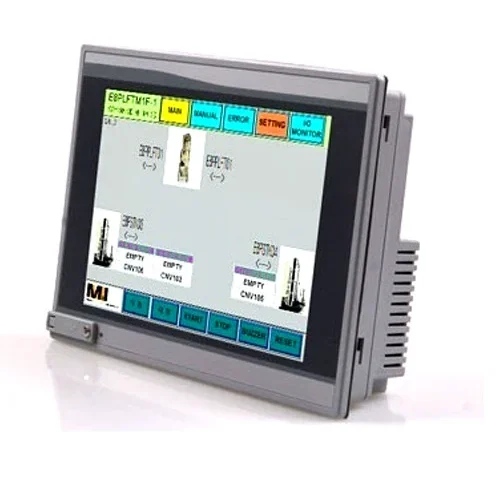
Human-Machine Interface (HMI) screens have become a critical component in modern automation systems, helping operators interact with machines more effectively. With industries becoming more advanced, the need for intuitive and user-friendly HMI screens has grown immensely. This blog will delve into what HMI screens are, how they work, and why they’re so crucial in today’s industrial landscape. We will also explore the benefits of using HMI screens and how they can improve operational efficiency.
What is an HMI Screen?
An HMI screen, or Human-Machine Interface screen, is a graphical user interface that allows operators and users to interact with machines and systems. It acts as a bridge between humans and the machines they control, enabling them to monitor and adjust various machine functions. An HMI screen can display data, provide visual cues, and allow operators to control processes through touch inputs or other commands.
Typically, HMI screens are used in industries like manufacturing, automotive, pharmaceuticals, and utilities. These screens are often integrated with programmable logic controllers (PLCs) and industrial control systems (ICS) to provide real-time information about operations.
Key Components of an HMI Screen
An HMI screen generally consists of the following essential components:
Display: The screen itself, which shows data, graphs, and control options. It can range from simple monochrome displays to advanced, full-color touchscreens.
Input Devices: These could be touchpads, buttons, or keyboards, depending on the design of the HMI system. Modern HMI screens primarily use touch interfaces for simplicity.
Software: The software running behind the interface is crucial for configuring the display and connecting it to the machine’s control system.
Control System Integration: HMI screens are linked with the machine’s control system (usually through PLCs), allowing the operator to monitor machine conditions, change settings, and troubleshoot problems.
How Does an HMI Screen Work?
An HMI screen operates by translating complex machine data into a user-friendly format:
Data Collection: Machines generate massive amounts of data during operations, such as temperature, pressure, speed, and more. This data is sent to the HMI screen from the connected PLC or control system.
Data Display: The HMI screen then organizes and displays this information visually—often in the form of graphs, gauges, and other digital representations. It makes it easy for operators to assess machine performance at a glance.
Control Interface: In addition to displaying data, an HMI screen allows operators to control different aspects of the machine. They can make adjustments, change settings, or even shut down a machine if needed—all through the interface.
Feedback Loop: The operator’s commands are fed back into the control system, which responds by adjusting the machine’s operations accordingly.
This closed-loop system ensures real-time monitoring and control, making the process more efficient and less prone to errors.
The Importance of HMI Displays in Industrial Automation
The rise of industrial automation has dramatically increased the demand for efficient and reliable HMI screens. Industries such as manufacturing and utilities rely heavily on automation to boost productivity, reduce errors, and improve safety. In this context, HMI screens are vital for several reasons:
Ease of Use: HMI screens make it easy for operators to monitor machine functions and make necessary adjustments without requiring in-depth technical knowledge.
Increased Efficiency: Real-time data displayed on HMI screens helps operators to detect issues early, reducing downtime and increasing operational efficiency.
Improved Safety: With an HMI screen, operators can monitor critical parameters like temperature and pressure. If anything goes wrong, alerts are displayed immediately, allowing operators to take swift action.
Enhanced Decision-Making: By presenting detailed information in an easy-to-understand format, HMI screens enable better decision-making, allowing companies to optimize their operations.
Types of HMI Screens
There are various types of HMI screens, each designed for different applications:
1. Basic HMI Screens
These are simple interfaces with limited functionality, often used in small-scale operations where complex data is not needed. Basic HMI screens usually display basic control functions like on/off switches and simple data readouts.
2. Advanced HMI Screens
These screens provide more complex graphical interfaces with advanced features such as data logging, multi-screen displays, and touch-screen interaction. They are typically found in large-scale industries like automotive manufacturing, oil refineries, and energy plants.
3. Web-based HMI Screens
With web-based HMI screens, operators can monitor and control processes remotely using a web browser. This is becoming increasingly popular in industries that require off-site monitoring, such as renewable energy plants.
4. Mobile HMI Screens
Mobile HMI screens are designed to work on tablets and smartphones, allowing operators to manage operations on the go. This type of HMI screen is ideal for remote workers or when access to the main control panel is limited.
Benefits of Using HMI Screens
Utilizing HMI screens provides numerous benefits to industries, helping them streamline their processes and improve overall productivity. Here are some key advantages:
Reduced Training Time: With easy-to-understand interfaces, operators need less time to learn how to use an HMI screen compared to traditional control systems.
Better Troubleshooting: The system can display detailed error messages and fault conditions, helping operators quickly identify and fix issues.
Data Logging and Reporting: Many advanced HMI screens can log historical data, which is essential for performance analysis, reporting, and ensuring compliance with industry standards.
Customizability: HMI screens are highly customizable. They can be tailored to meet the specific needs of a business, ensuring operators have all the necessary tools at their fingertips.
Conclusion
In conclusion, HMI screens are an essential tool in the modern industrial landscape, bridging the gap between humans and machines. They make industrial operations easier, safer, and more efficient by providing real-time data and control options. As technology advances, the capabilities of HMI screens are set to grow, making them even more indispensable in the world of automation. Whether it’s basic data monitoring or advanced process control, HMI screens are helping industries around the world achieve new levels of operational excellence.


